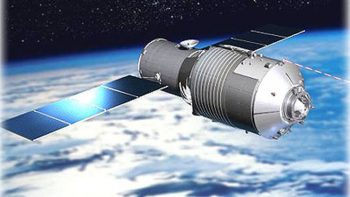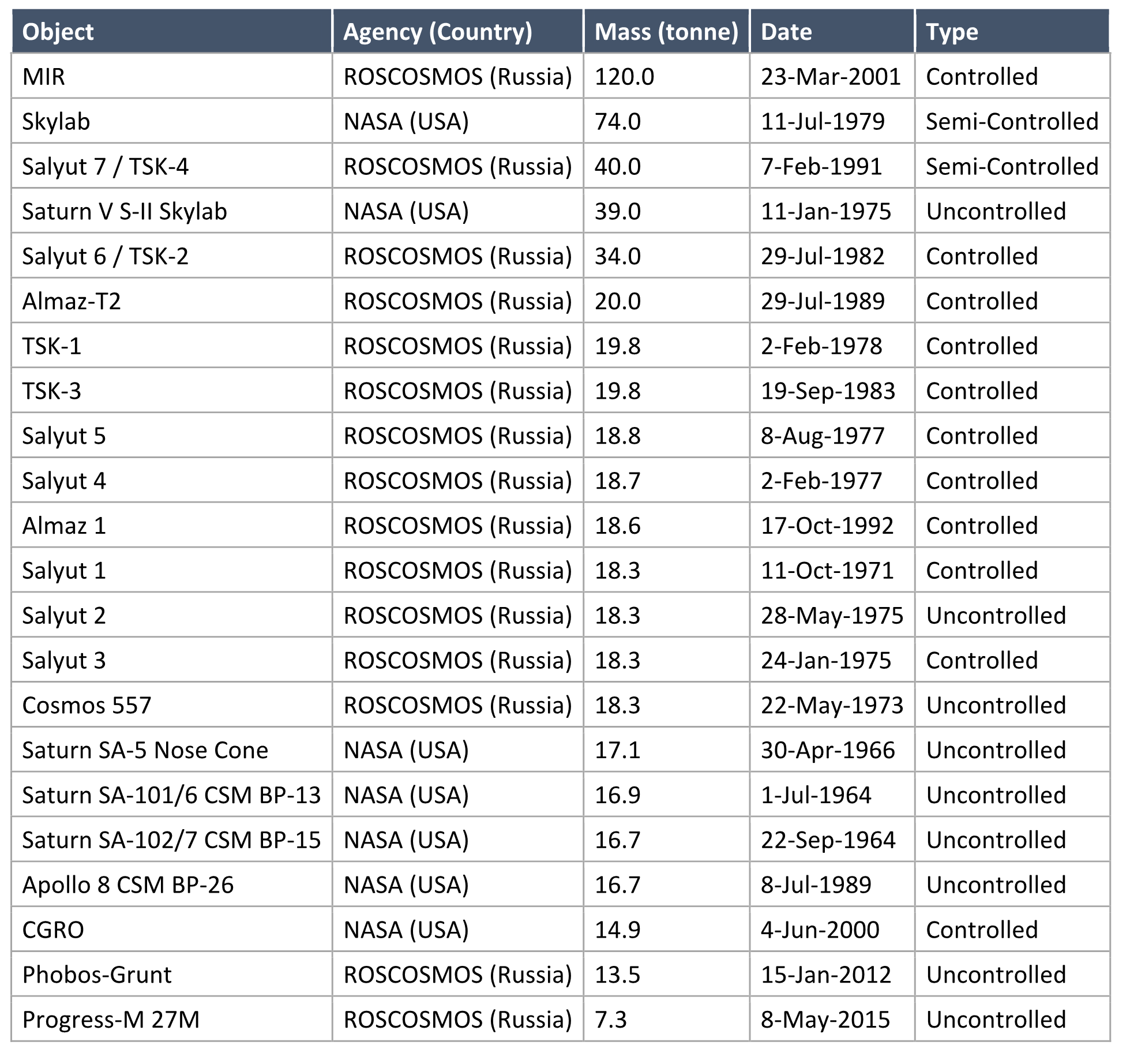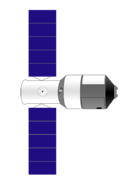FAQ on Tiangong-1 reentry
FAQ prepared and updated by the Space Debris Office, ESA/ESOC, Darmstadt, Germany.
Hier lesen Sie dieses FAQ in deutscher Sprache
Preguntas frecuentes sobre la reentrada de Tiangong-1
Domande frequenti in italiano
Tiangong-1 (天宫一号, Heavenly Palace 1) is China’s first space station and an experimental space laboratory. Its major goal was to test and master technologies related to orbital rendezvous and docking. It is identified by its UN COSPAR ID 2011-053A. It was launched on 30 September 2011 at 03:16:03.507 UTC by a Long March 2F/G rocket from the Jiuquan Satellite Launch Centre in the Gobi desert, Inner Mongolia, China. One uncrewed and two crewed missions, executed by the Shenzhou (神舟, Divine Craft) spacecraft, took place during its operational lifetime.
Note: The latest, updated reentry time window forecast will be posted in the homepage of this blog. Read more via ESA joins reentry campaign.
Q. What’s happening?
The Tiangong-1 space station will reenter Earth’s atmosphere and substantially burn up in the March–April 2018 timeframe.
As of mid-January 2018, the spacecraft was at about 280 km altitude in an orbit that will inevitably decay; it will mostly burn up due to the extreme heat generated by its high-speed passage through the atmosphere (some spacecraft, like Soyuz capsules, are designed to withstand reentry).
Following launch in 2011, the Tiangong-1 orbit began steadily decaying due to the faint, yet not-zero, atmospheric drag present even at 300 or 400 km altitude. This affects all satellites and spacecraft in low-Earth orbit, like the International Space Station (ISS), for example.

Tiangong-1 space station. Credit: CMSE/China Manned Space Engineering Office
As a result, such craft must conduct regular ‘reboost manoeuvres’ to maintain their orbit – typically, ground controllers command the craft’s engines or thrusters to fire for a certain amount of time, speeding it up so that it gains altitude.
During its operational life from launch through to December 2015, regular orbital maintenance manoeuvres were executed by Tiangong-1 in order to maintain an operational altitude of between 330 and 390 km above the Earth’s surface.
Q. What was the original disposal plan?
Initially, a ‘controlled reentry’ was planned for the spacecraft at the end of its life.
This means that ground controllers would have commanded the engines to fire, slowing the craft by a significant amount so that it would fall toward the surface. Firing the engines would have been done at a specific moment so that it would reenter the atmosphere and substantially burn up over a large, unpopulated region of the South Pacific ocean. Any surviving pieces would fall into the ocean, far from any populated areas. This is precisely what ESA did, for example, for the Agency’s series of five ATV cargo spacecraft between 2008 and 2015.
However, in March 2016 the Tiangong-1 space station ceased functioning but maintained its structural integrity. In so far as can be fully confirmed, ground teams lost control with the craft, and it can no longer be commanded to fire its engines. It is, therefore, expected to make an ‘uncontrolled reentry.’
Q: How big is Tiangong-1? What shape is it?
The spacecraft’s 10.4 m-long main body is made up of two cylinders of approximately equal length: a service module and an experiment module. The thinner service module provides power and orbit control capabilities for the station. It has two solar panels, each approximately 3 x 7 m in size. The thicker experimental module comprises an enclosed front conical section, which include a docking port, a cylindrical section, and a rear conical section. The experimental module is habitable.

This vivid image shows China’s space station Tiangong-1 – the name means ‘heavenly palace’ – and was captured by French astrophotographer Alain Figer on 27 November 2017. It was taken from a ski area in the Hautes-Alpes region of southeast France as the station passed overhead near dusk. The station is seen at lower right as a white streak, resulting from the exposure of several seconds, just above the summit of the snowy peak of Eyssina (2837 m altitude). Credit: A. Figer. Used by permission.
The overall mass of the spacecraft was reported to have been approximately 8.5 tonnes including fuel at launch. Given that the space station exceeded its originally planned operational lifetime of two years and continued operating successfully for two more years after that, a considerable amount of fuel must have been consumed to sustain the orbit and the habitable environment conditions inside.
This means that a significantly lower mass on reentry is likely, comparable to the mass of defunct satellites that make uncontrolled reentries typically a couple times per month.
Q. To date, who’s done or is doing what?
China notified the United Nations Office for Outer Space Affairs (UNOOSA) of the upcoming re-entry and committed to enhanced monitoring and forecasting of the orbital decay, including requesting an international joint monitoring and information dissemination campaign under the framework of the Inter-Agency Space Debris Coordination Committee (IADC).
IADC comprises space debris and other experts from 13 space agencies/organisations, including NASA, ESA, European national space agencies, JAXA, ISRO, KARI, Roscosmos and the China National Space Administration.
IADC members will use this event to conduct their annual reentry test campaign, during which participants will pool their predictions of the time window, as well as their respective tracking datasets obtained from radar and other sources. The aim is to cross-verify, cross-analyse and improve the prediction accuracy for all members.
ESA is acting as host and administrator for the campaign, as it has done for the twenty previous IADC test campaigns since 1998. A special case for ESA was the campaign in 2013 during the uncontrolled reentry of ESA’s own GOCE satellite.
Regular updates are being provided via the website of the China Manned Space Agency in both Chinese and English.
As of January 2018, the mean altitude of the space station is 280 km. The further decay, and hence re-entry, is assumed to be uncontrolled in the sense of orbit maintenance. This has, however, not been unambiguously confirmed by the Chinese authorities. It has however been reported that the attitude, i.e. the orientation, of Tiangong-1 is stabilised.
Q. Over which parts of Earth will it burn up?
Due to the orbital inclination of the Tiangong-1, approximately 42.8 degrees, and the likely uncontrolled nature of the reentry, the final impact point can be anywhere on Earth between 42.8 degrees North and 42.8 degrees South in latitude.

Map showing the area between 42.8 degrees North and 42.8 degrees South latitude (in green), over which Tiangong-1 could reenter. Graph at left shows population density. Credit: ESA CC BY-SA IGO 3.0
As you can see in the chart at right in the map above, the re-entry location itself is not uniformly distributed. Due to the geometry of the craft’s circular orbit, the probability of reentry happening at the maximum (42.8 degrees N) and minimum (42.8 degrees S) latitude are higher than at the equator.
Why is this?
Because of the low eccentricity and non-polar inclination of the orbit (in other words, because the orbit of the space station around the Earth is circular and at an angle with respect to the equator), the space station spends more time near the edges of the band then it spends crossing the equatorial region of Earth. This leads to a higher likelihood of reentry occurring near the edges of the latitude band, i.e., the top and bottom of the band in the map above.
Q. Will it completely burn up during reentry?
At launch, the total mass of the space station was about 8.5 tonnes (including fuel). Following its launch in September 2011, Tiangong-1 operated successfully for two full years on its scheduled operational mission plus an additional two years, and much of its fuel must have been consumed to maintain orbit altitude and maintain conditions inside the module. This means that the station’s mass is likely to be significantly lower on reentry, comparable to other end-of-life satellites, of which each month, typically, 3-4 uncontrollably reenter Earth’s atmosphere. Tiangong-1’s mass without fuel is estimated to be, therefore, about 7.5t.
Through comparisons with similar reentries, and simulations for objects of similar mass and size, we may not exclude that a (small) fraction of the Tiangong-1 mass may reach ground, in some fragments, distributed over a large footprint area. It is very difficult to estimate how much, precisely, without more knowledge of the spacecraft’s design and construction.
Q. Will anyone know the precise location and time of reentry in advance?
Only from one day before the actual reentry will it become possible to roughly predict which ground tracks, and hence which regions on Earth, might witness the reentry.
But even then, an impact location prediction on the order kilometres is, for an uncontrolled reentry, beyond current technical capabilities due to complexities of modelling the atmosphere, the dynamics of the reentering object and limitations in observing the spacecraft.
(See our separate blog post here.)
In general, the uncertainty associated with an uncontrolled reentry prediction is on the order of 20% of the remaining orbital lifetime. Practically, this means that even 7 hours before the actual reentry, the uncertainty on the break-up location is a full orbital revolution – meaning plus or minus thousands of km!
The latest reentry forecast will be posted here.
If the spacecraft does have a functioning attitude control system now, this could stop working under the higher dynamic pressure loads (due to falling lower into the atmosphere) closer to reentry and the uncertainty in the final reentry time window could rise (this was the case, for example, with ESA’s GOCE reentry).
Q. Once it reenters and breaks up, what is the risk that any pieces reach ground?
Tiangong-1 is a large spacecraft comparable in size and mass to other, frequently used space stations and cargo vessels such as ESA’s ATV, the Japanese HTV, Russian Progress and American Dragon or Cygnus.
From monitoring the controlled reentries of those types of spacecraft, it can be surmised that Tiangong-1 will break up during its atmospheric re-entry and that some parts will survive the process and reach the surface of Earth.
Video of ESA’s ATV 1 breaking up during its controlled reentry in September 2008
Given the uncontrolled nature of this reentry event, the zone over which fragments might fall stretches over a curved ellipsoid that is thousands of kilometres in length and tens of kilometres wide. While a wide area could be affected, it is important to point out that a large part of the Earth is covered by water or is uninhabited.
Hence the personal probability of being hit by a piece of debris from the Tiangong-1 is actually 10 million times smaller than the yearly chance of being hit by lightning.
In the history of spaceflight, no casualties due to falling space debris have ever been confirmed.
Q. How does Tiangong-1 reentry compare to the reentries of similar-size craft in the past?
With its 8.5 metric tonnes of (initial) mass, Tiangong-1 is definitely not the largest uncontrolled reentry in spaceflight history. That would be Skylab with 74 metric tonnes.
Tiangong-1 falls within the category of modern space freighters (crewed and uncrewed) such as the already mentioned ATV (12 t), Japan’s HTV (10 t), Russia’s Progress (7 t) and Soyuz (7 t), the US Dragon (7 t) or Cygnus (5 t) and the Chinese Tianzhou (13 t). These masses are for the loaded craft; in the table below, they are shown at reentry.

Tiangong-1-class reentries Credit: ESA CC BY-SA 3.0 IGO Note: Shuttle Colombia (STS-107), with a mass of 82 t, unexpectedly broke up during a controlled reentry on 1 Feb 2003, leading to the loss of vehicle and crew.
Q. How will ESA share news or updates on the reentry?
In addition to news posted here in the blog, ESA will regularly update authorities in ESA Member States with detailed information on the reentry, as it does during all such events.
Q. What is ESA doing to tackle the problem of space debris?
ESA is leading the effort to tackle the problems of space debris by:
- Monitoring and tracking objects in space
By the end of the 2009-2020 period, ESA’s Space Situational Awareness (SSA) Programme will have overseen an investment of €200 million aiming to develop Europe-wide warning systems for space weather, near-Earth objects (such as asteroids) and debris objects left in orbit by human activities. Within SSA, ESA is developing and demonstrating the technologies needed to find and track debris and alert satellite operators – who control our vital weather, navigation, telecommunication and science research satellites – when evasive action may be necessary. - Developing technologies to mitigate and remediate space debris
ESA’s Clean Space office launched the CleanSat project to support European Industry in developing technologies for spacecraft in low-Earth orbit that will then be fully compliant with debris-mitigation regulations. CleanSat covers four technology areas:1. Passivation: Explosions of satellites are a major source of debris. Passivation reduces the likelihood of a satellite exploding in the future by deactivating its power systems and batteries and venting any leftover propellant.2. Design for demise: Many spacecraft reenter the atmosphere. By using materials and designs that are likely to burn up entirely, the engineers are reducing the chances that pieces are left to hit the ground.3. Deorbiting systems: International debris guidelines require satellites to remove themselves from low-Earth orbit within 25 years of their end of life. ESA is carrying out studies to develop technologies that will ease the deorbiting at the end of life without affecting mission efficiency (examples include compact solid robot thrusters for deorbiting and ‘terminator sails’ that could be unfurled to increase air drag and hasten reentry).4. Design for servicing: This involves incorporating standard features onto future satellites, such as grips and handles, that will enable robotic servicing missions to capture satellites for removal, repair or refuelling.
While the first action to tackle the challenge of space debris is to stop producing further debris, it is also important to remove the largest items of debris currently in heavily-trafficked orbits, as a preventative measure to reduce the likelihood of future explosions or collisions.
ESA’s Clean Space office is working to prepare the first ‘active debris removal’ (ADR) mission, called e.Deorbit. The objective of the mission is to use a custom satellite – the chaser – to capture a heavy, ESA-owned derelict satellite and remove it from an altitude of 800-1000 km and a near-polar orbital trajectory. The mission will be also an opportunity to demonstrate technologies needed for target characterisation, disposal methods and capture mechanisms – three technology areas of high interest to ESA and European industry for future space servicing vehicles.
Q. What specific technologies will help avoid future reentries such as this?
While not a specific technology, the main way for any spacecraft operator to avoid reentries such as this is to ensure that their missions are fully capable of conducting controlled, completely destructive reentries at the end of life. The specific technological approach taken depends on the mass of the spacecraft in question:
- For satellites up to 1-2 tonnes: Technologies which will enhance ‘design for demise’ during reentry in the atmosphere. By using materials that are likely to burn up entirely during reentry and designs that will encourage complete breakup at an early point in the reentry process, already in the manufacturing phase engineers can reduce the chances that any pieces survive reentry to reach the surface.
- For larger satellites: Efficient controlled deorbiting systems are needed. ESA is conducting studies to develop technologies that will ease deorbiting at the end of life without affecting overall mission efficiency, such as improved pressure gauges to maintain an accurate measure of the propellant remaining in a spacecraft’s fuel tank.
Access more information Clean Space and on the technologies under development within the CleanSat project via ESA’s CleanSpace blog.
More information
Media and press seeking more information can contact the ESA Communication team as follows:
esoc.communication@esa.int
ESA/ESOC Communication Office +49 6151 90 2516
Need more information on space debris?
ESA media relations website


Discussion: 14 comments
Mahalo for your efforts to keep us all updated!
Is there any radioactive material on board that might pollute the atmosphere?
The thick green lines on the map is the actual orbit of the station?
Photo’s taken tonight at 7:56pm AEST 21/3/2018.
https://forum.cosmoquest.org/showthread.php?152373-China-Space-Station&p=2443790#post2443790
I just captured another pic of TIANGONG 1 passing over head at 7:21pm AEST 23 March 2018.
https://forum.cosmoquest.org/showthread.php?152373-China-Space-Station&p=2443977#post2443977
oh, just saw that the impact probability is actually high on the edges. my bad.
Actually the statement of no casualties is incorrect. Casualty means death OR injury. There have been two people injured by space objects. One was hit in her home by a meteorite, and the other (A Lady in Tulsa Oklahoma) was hit by a shard of a boost stage. Both were minor injuries, but required medical care, which I believe meets the definition of casualty.
Sylacauga, Alabama for the lady struck by meteorite.
Wikipedia tells us the earliest claim of a person being hit by a meteorite comes from 1677 in a manuscript published at Tortona, Italy, which tells of a Milanese friar who was killed by one, although its veracity is unknown.. Certainly it would qualify as a casualty. In 1992 a small meteorite fragment (3 g) hit a young Ugandan boy in Mbale, but it had been slowed down by a tree and did not cause any injury therefore not qualifying as a casualty.
On your graphs where tic marks are labeled with a date — what time of day goes with the date? Noon? Midnight? And which timezone (UCT, I assume?) Thanks!
At what altitude does the light show begin? How low to start burning up?
What is the critical altitude where it will begin to burn up / free fall? I’m thinking around 65 miles (104 KM) ?
Why not shooting it a missile to break it up in smaller fragments before reentry?
A space rendezvous is an orbital maneuver during which two spacecraft, one of which is often a space station, arrive at the same orbit and approach to a very close distance.